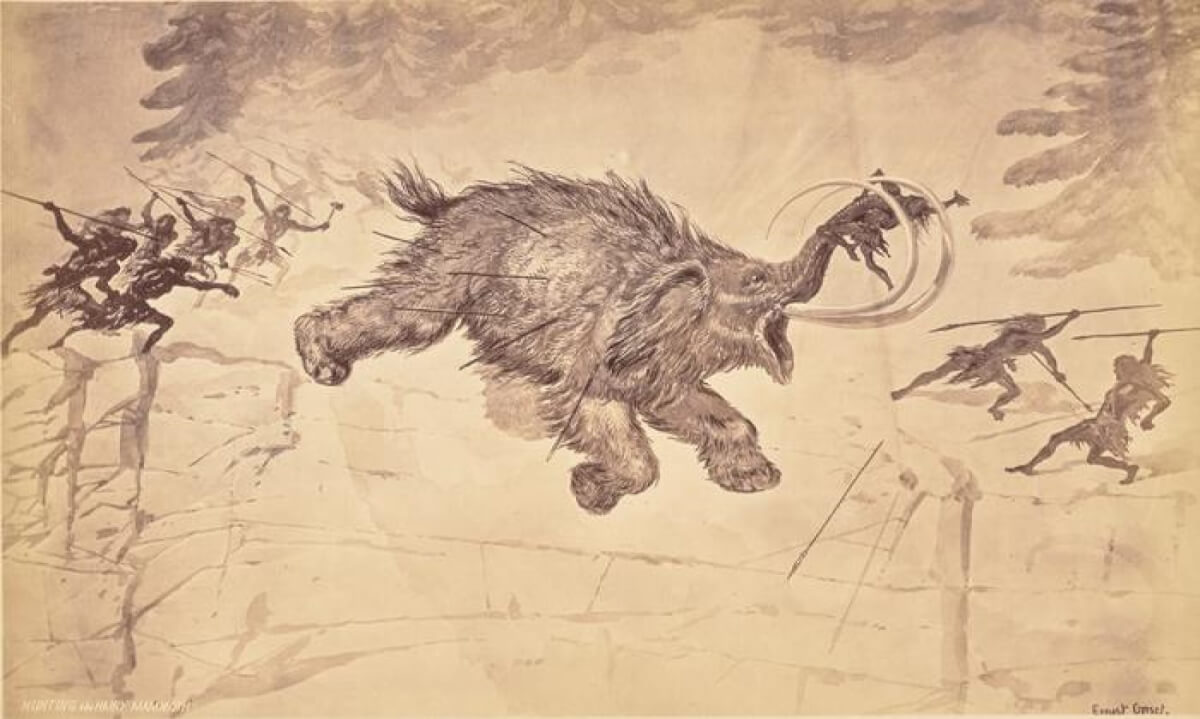Scribbled in French shorthand, Louise Hamel’s diary still captures the power of the moment
‘It was very intense’: Vets travel to France for D-Day anniversary
Dozens of United States World War II veterans traveled to France to mark the 80th anniversary of the D-Day landing.
COLLEVILLE-SUR-MER, France – A single sentence in the fading pages of Louise Hamel’s diary documents the first moments of the day that would become a turning point in World War II.
Tuesday, June 6, 1944.
“Les Americans débarque en France,” read Hamel’s diary entry, seemingly written too quickly for proper accents and grammar.
The English translation: “The Americans are landing in France.”
The wife of a French farmer held prisoner by the Germans in Czechoslovakia, Hamel concisely recorded the moment when nearly 133,000 troops from the United States, Great Britain, Canada and other allies began to land in Normandy on D-Day to liberate Europe from the control of Nazi Germany. Nearly 4,500 would die in the intense fighting that followed, but their cross-channel invasion of Nazi-occupied France would slowly turn the tide of the war.
Hamel was forever grateful to the soldiers who sacrificed so much so that France could again be free. For the rest of her life, she would do her part to honor the memory of those who never made it out alive.
In 1947, her family donated farmland to create the Normandy American Cemetery, the final resting place for more than 9,000 of the fallen heroes, most of whom lost their lives in the D-Day invasion and the operations that followed.
On Thursday, President Joe Biden and other world leaders will travel to the cemetery overlooking the English Channel for a ceremony commemorating the 80th anniversary of D-Day. In the audience will be some of the veterans who fought in Normandy, many of them returning for the first time since the war.
For Hamel, “it was always important to thank the liberators, to not forget what they did for her and our freedom today,” said her granddaughter, Stéphanie Le Bris, an interpretative guide at the cemetery.
Le Bris, 48, discovered her grandmother’s diary after her death in 2006 at age 86. The small booklet and some of Hamel’s other belongings were kept in a sewing box that relatives found on the family farm. When Le Bris opened the diary, her eyes fell immediately upon the D-Day entry and her grandmother’s understated account of the Allied troops’ landing.
In a sense, Hamel’s diary is a historical record, one young woman’s eyewitness version of events that would put Allied forces on the path to winning the war.
For Le Bris, it is much more.
“It was,” she said, “my last gift from my grandmother.”
‘What is happening to you?’
The fighting started early that morning.
At 6:30 a.m., the first wave of Allied troops came ashore at Omaha Beach, not far from the farmhouse in the Normandy village of Colleville-sur-Mer, where Louise Hamel lived with her daughter and her husband, Félix, before he had gone off to fight for France.
German bullets rained down and punched the waters of the English Channel as the soldiers jumped from their landing craft and waded to the shore. Still, they slogged through the waters, rifles in hand, and eventually reached the beach, where more enemy fire awaited them. At Pointe du Hoc to the west, rangers using rope ladders scaled the tall cliffs overlooking the blue waters below. From the top of the promontory, Germans watched their advance and pummeled them with heavy machine gun fire and hand grenades.
Hamel was home when the fighting broke out. She had been advised to stay away from the beach and, if possible, to leave the village altogether. As the combat intensified, the 24-year-old mother fled Colleville with her daughter and mother-in-law and headed for the safety of the French countryside.
They would not return until noon the next day, June 7, after the village had been liberated.
Hundreds of miles away, Félix Hamel hungered for news of his family. Mobilized by the French Army in 1940, he had been arrested by the Germans a few days later and sent to Czechoslovakia. Given his agrarian background, the Germans put him to work on a farm.
“My dearest, darling Lissette,” he wrote to his wife in a letter dated Aug. 2, 1944. “What is happening to you? Still no news from you. I have written everywhere, Belgian, American, English and French Red Cross. As of today still no news. … Seeing what’s happened there, I have to think positively. Me, my health is good. Hoping as always that I will soon receive a letter from you, receive from your Félix, a thousand tender kisses.”
Félix Hamel remained in captivity until the final weeks of the war.
Finally freed in May 1945, he returned to Colleville and his darling Lissette. One day he went to check on the family farmland, to see how it had fared during the war. At the top of hill, he saw not animals but coffins. The land had been turned into a morgue.
A couple of years later, the French government approached him with a proposal: Would the family donate their land to create a permanent cemetery and memorial for the soldiers who had fought and died in France?
He said yes, of course. How could he say no?
Honoring the fallen
Félix Hamel seldom spoke about the war or his time in captivity.
Le Bris’ knowledge of the family’s wartime history comes from what she was able to piece together from his letters to Louise and from her own conversations with her grandmother, who spoke often of her endless gratitude to the soldiers who liberated France.
Louise Hamel, who lived her entire life in Colleville, never forgot the sacrifices of the soldiers that day and worked for the rest of her life to honor their memory.
For years, she attended the Memorial Day celebration for the soldiers who never made it out of Normandy alive and continued to place flowers on their graves – a tradition she and other French women had started just a couple of weeks after D-Day, when the fallen soldiers were resting in temporary graves.
A black-and-white photo Le Bris discovered in a museum decades later shows several women, baskets in hand, decorating what appears to be freshly covered graves. Le Bris did some sleuthing and discovered that one of the women is her grandmother.
In 1999, the U.S. Army’s First Infantry Division, whose soldiers were among the first to storm Omaha Beach and faced some of the fiercest resistance, presented Hamel with their insignia, a shoulder patch with a red numeral “1” centered on a green shield. She treasured the gift and the sentiment it represented.
“She told my father, ‘When I die, I would like to have the insignia in my casket for my funeral,’” Le Bris said. “This period of her life was really, really important to her.”
Le Bris, who was 15 when her grandfather died, often accompanied her grandmother and other family members to the cemetery to pay their respects. “Every June 6, we went at 6:30 in the morning to see the reenactment on the sea,” she said.
On the 50th anniversary of D-Day, the family attended the World War II commemorations, then invited some of the veterans back to their home. “They slept at the farm,” Le Bris said. “I knew for (my grandmother) that it was really important to welcome them. It was a way to thank them for what they did.”
Le Bris worked as a travel agent in Paris for six years but in 2007 landed a job as an interpretative guide at the cemetery, one of several overseas burial sites managed by the American Battle Monuments Commission. The Normandy cemetery and memorial receive more than 1 million visitors every year.
Le Bris gives tours in English and French, welcomes family members of fallen soldiers and helps them find their loved one’s burial plot among the thousands of white marble headstones shaped like crosses or Stars of David.
She never talks about her own family history unless someone asks if her relatives were there on D-Day. Only then does she tell them the story of Louise and Félix and the many other French citizens who were part of the resistance.
“Every day, and especially when I’m alone in the cemetery, I think about the courage of these people that were civilians and that were soldiers and what they did,” she said.
Le Bris will be at the cemetery on Thursday for the D-Day commemorations. If her grandmother were alive, Le Bris knows she’d be there, too. In her honor, Le Bris plans to wear a small piece of jewelry, a gold Napoleon Bonaparte coin that once belonged to Louise Hamel.
“That’s the way,” Le Bris said, “for me to have her with me.”
Even in death, Louise Hamel is still paying her respects those who helped free France.
Michael Collins covers the White House. Follow him on X, formerly Twitter, @mcollinsNEWS.

Abhinav Thawait is a globe-trotting correspondent with a passion for international affairs. With a background in international relations, he offers a global perspective on the most pressing issues around the world. Abhinav’s curiosity takes his to the far corners of the earth, where he seeks to share untold stories and diverse viewpoints.







